I just got back from a 16-day, 14-presentation, 100s-of-entrepreneurs, 11-accelerator, 3-factory visit to Shanghai, Shenzhen, Hong Kong and Taipei, where my colleague Ben Bateman (@Gilbetrar) and I did a whirlwind tour of the exploding “maker movement.”
In the US we might use the term “entrepreneur” rather than “maker”, but whatever you want to call it, there is a huge commitment both from above (government) and from below (everyday people) to help makers take advantage of a powerful confluence of trends: amazing access to low or no-cost technology and components, huge numbers of young, well-educated people eager to experiment with products and companies, ready manufacturing facilities increasingly open to “small runs,” and global interest in all things IoT, wearable and tech. Welcome to China* 2015!
*We recognize putting Hong Kong and Taiwan into the broader bucket of China is politically controversial, but for the purposes of this blog we are simplifying as the trends discussed are happening in all the cities we visited (and many we didn’t).
First a little background. Shanghai, pictured below, ‘officially’ has 23M residents, but everyone who lives there tells me there are a lot more! As someone who lives in New York City I can tell you that Shanghai blew me away in terms of skyscrapers, malls (so. many. malls.), infrastructure, and utter vastness. This panorama shot captures just one section — and the view behind me was equally as built up.
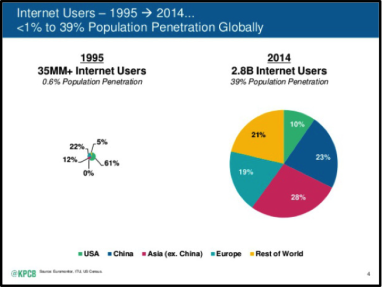 It’s extremely modern. Everything is shiny, new and efficient. The metro is amazing and inexpensive, the restaurants are fantastic (and you get a WeChat message when your table is ready) and the economy appears to be booming, even if China’s GDP growth has slowed from an insane 10% to a still covetable 7%.
It’s extremely modern. Everything is shiny, new and efficient. The metro is amazing and inexpensive, the restaurants are fantastic (and you get a WeChat message when your table is ready) and the economy appears to be booming, even if China’s GDP growth has slowed from an insane 10% to a still covetable 7%.
The educated/wealthy all have a VPN on their phones (everyone is mobile) and regularly access all of the internet, including FB, Twitter, etc. And as Mary Meeker recently pointed out, Internet users in China have exploded in the past 20 years – that blue slice is China.
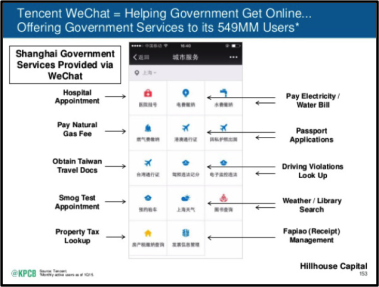 And it’s not just the users who are vast, the companies providing products and services in China are enormous: Baidu, Alibaba, and Tencent, aka “B.A.T” to locals, are among the top 10 publicly traded internet companies based on market capitalization worldwide (Apple is #1 and most of their products are produced in Shenzhen, China).
And it’s not just the users who are vast, the companies providing products and services in China are enormous: Baidu, Alibaba, and Tencent, aka “B.A.T” to locals, are among the top 10 publicly traded internet companies based on market capitalization worldwide (Apple is #1 and most of their products are produced in Shenzhen, China).
The first thing Ben and I did when planning our trip was set up our WeChat accounts–feel free to scan the QR codes below and connect!
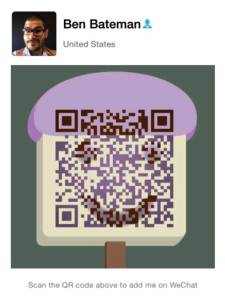
 People on mainland China absolutely love and live by WeChat, which is owned by Tencent. There are 549M active WeChat users, yeah that’s 1.7x the US population. And they can do a whole lot more than chat and share stickers–they love stickers!
People on mainland China absolutely love and live by WeChat, which is owned by Tencent. There are 549M active WeChat users, yeah that’s 1.7x the US population. And they can do a whole lot more than chat and share stickers–they love stickers!
If you are from mainland China (not Taiwan, not sure about Hong Kong) you can also shop from your WeChat account, which is quickly eating into AliPay’s dominant position.
Ok, back to our trip. We anchored our visit around the inaugural CES Asia, which was a whole lot smaller than the Vegas version, but will definitely grow quickly. The show was a combination of up and coming startups, like G-Wearables who recently launched a campaign for the Gogo-S: Wireless Waterproof Earbuds and car companies like Mercedes, showing off self-driving cars of the future.
Our friends from Ghost Drone had a great booth, and we met lots of people who came from all over China to this first-time event. There were lots of connected devices (speakers, toothbrushes, coffee cups, kitchens, etc.) and plenty of phone chargers and 3D-printers, but there weren’t too many really futuristic items.
The top of my list from the “really, people buy this?” category, was the “Shape Up, Face Up Exerciser!” Apparently, Cristiano Ronaldo thinks this is awesome. His publicist is smart and apparently only allows him to pose for the ‘after’ photo, not the action shot!
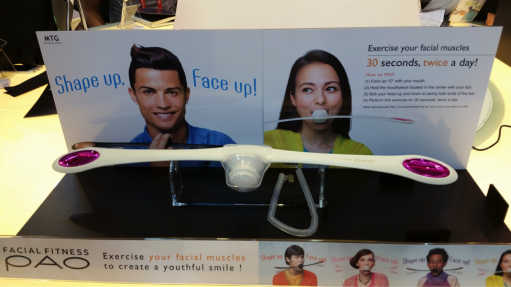 After three days at CES and several meetings with potential campaigners in Shanghai, along with a fun night talking to makers at “AC117: Smart Hardware Accelerator” (aka Maker Collider) we made our way to what is arguably the capital of all maker activity in China: Shenzhen.
After three days at CES and several meetings with potential campaigners in Shanghai, along with a fun night talking to makers at “AC117: Smart Hardware Accelerator” (aka Maker Collider) we made our way to what is arguably the capital of all maker activity in China: Shenzhen.
For those of you who have heard about the factories in Shenzhen and are picturing a post-apolyptic, dystopia where the air is unbreathable and the sky is never blue, think again. This place reminded me of Vegas! Over the past 35 years, this former fishing village of 300,000 has turned into a mini Shanghai with over 13M people all of whom seem to work in the hardware business — either literally assembling products or coming up with the next great idea.
Our first stop was the thoroughly decked out Stargeek Acclerator (pictured below), backed by well-funded VC “Legend Star”. It was a great space with plenty of tech toys, like 3D printers, to play with. We had the fortune of visiting several such accelerators, co-working spaces and other places created to bring makers together. We were uniformly impressed with the real estate, organizers, and makers themselves.
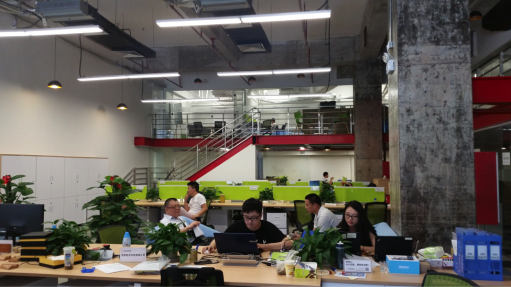 The cool thing about being in Shenzhen is that if you need a part for your prototype, or just a new charger to keep your phone powered up, you can pop on over to Huaqiangbei, the mega market for all things electronic. In fact, to access this nirvana of electronics even easier, there will soon be a makerspace right in the heart of Huaqiangbei.
The cool thing about being in Shenzhen is that if you need a part for your prototype, or just a new charger to keep your phone powered up, you can pop on over to Huaqiangbei, the mega market for all things electronic. In fact, to access this nirvana of electronics even easier, there will soon be a makerspace right in the heart of Huaqiangbei.
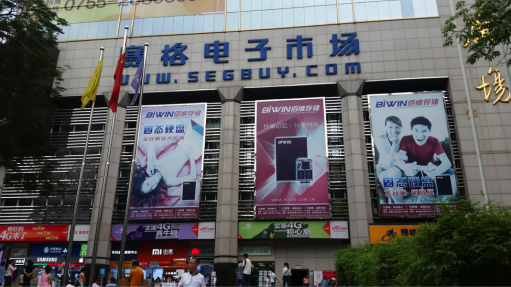 It’s nearly impossible to describe the scene here, but try to imagine a few city blocks of multi-story buildings filled to the brim with any electronic device you could imagine and a few hundred thousand people milling around. You can buy the real thing or a knock off depending on your budget, but good luck choosing! Of course the reason so much maker activity is happening in Shenzhen is because of all the manufacturing, or more accurately, assembly that occurs here. A “factory” can be as small as a single line, mid-size and full-service like PCH Access, or as big as an entire city like Foxconn, with more than 300,000 people (!) at their Shenzhen location.
It’s nearly impossible to describe the scene here, but try to imagine a few city blocks of multi-story buildings filled to the brim with any electronic device you could imagine and a few hundred thousand people milling around. You can buy the real thing or a knock off depending on your budget, but good luck choosing! Of course the reason so much maker activity is happening in Shenzhen is because of all the manufacturing, or more accurately, assembly that occurs here. A “factory” can be as small as a single line, mid-size and full-service like PCH Access, or as big as an entire city like Foxconn, with more than 300,000 people (!) at their Shenzhen location.
 We got an insider tour of the Foxconn testing center where we saw items being put through the rigors of extreme heat, bitter cold, high-impact drops, electricity surges and every other trauma you can wreak on a device. Behind some well-guarded curtains the mythical iPhone 7s were being put through their paces.
We got an insider tour of the Foxconn testing center where we saw items being put through the rigors of extreme heat, bitter cold, high-impact drops, electricity surges and every other trauma you can wreak on a device. Behind some well-guarded curtains the mythical iPhone 7s were being put through their paces.
Since they don’t allow laptops or cellphones in the building our only photo was of this manhole cover in the lobby!
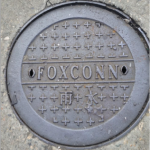 The hardware industry is going through a complete overhaul with time to market decreasing dramatically, and total unit requirements dropping , enabling start-ups to actually compete with behemoth companies. For a snapshot of the changing landscape check out this nice graphic that explains the industry shift, courtesy of Buzzfeed (source)
The hardware industry is going through a complete overhaul with time to market decreasing dramatically, and total unit requirements dropping , enabling start-ups to actually compete with behemoth companies. For a snapshot of the changing landscape check out this nice graphic that explains the industry shift, courtesy of Buzzfeed (source)
 Another advantage of Shenzhen is its proximity to Hong Kong, which is a 90-minute ferry ride away. Hong Kong combines the entrepreneurial spirit of Shenzhen with the financial power of Shanghai and the grit of New York — it’s a great city. We arrived there on a cloudy, hot Friday morning in time for a visit to Cyberport, a creative digital community with a cluster of technology and digital content tenants including our friends from Jolla Tablet and Bluesmart.
Another advantage of Shenzhen is its proximity to Hong Kong, which is a 90-minute ferry ride away. Hong Kong combines the entrepreneurial spirit of Shenzhen with the financial power of Shanghai and the grit of New York — it’s a great city. We arrived there on a cloudy, hot Friday morning in time for a visit to Cyberport, a creative digital community with a cluster of technology and digital content tenants including our friends from Jolla Tablet and Bluesmart.
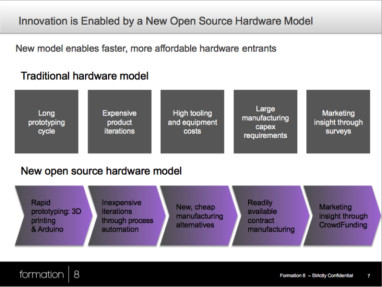 Bluesmart was kind enough to be a guest speaker at our Friday night event hosted by StartwareHK where they shared their experience of running an Indiegogo campaign and talked a bit about their decision to move to Hong Kong to tightly manage the production of their connected carry-on.
Bluesmart was kind enough to be a guest speaker at our Friday night event hosted by StartwareHK where they shared their experience of running an Indiegogo campaign and talked a bit about their decision to move to Hong Kong to tightly manage the production of their connected carry-on.
Our friends at Brinc.io also hosted an event for us from their cool new digs and we heard campaign advice from both Soundbrenner, a wearable vibrating metronome and Aumeo, an audio solution tailored to the individual listener.
The final stop on our our trip was Taipei, Taiwan, which felt a bit like the older, calmer brother of Shenzhen. We didn’t have time to do many events, the great people at HWTrek pulled together a great group for us that included presentations from several entrepreneurs and lots of questions from the Taiwanese press. You can read all about in the article below (if you read Chinese).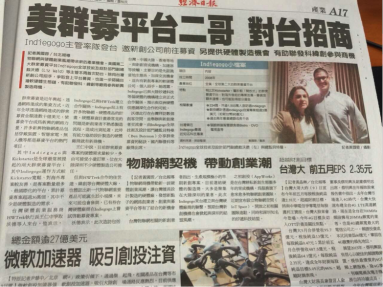
Ben and I, and the whole Indiegogo tech team are super excited about the trends we’re seeing in China. We’re eager to work with many of the movers, shakers and makers we’ve already met, and to get to know many more in the months and years to come. We’ll definitely be back!
Please reach out to technology@indiegogo.com if you are interested in running a campaign or want more information about our efforts in China.
谢谢 (Xièxiè, pronounced “shay shay”)
One Response
You must be logged in to post a comment.
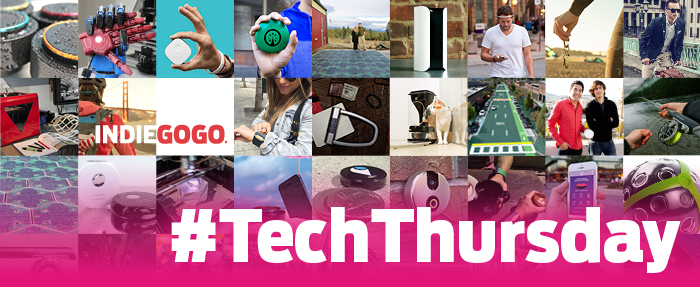




* post-apoCAlyptic